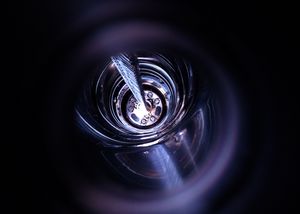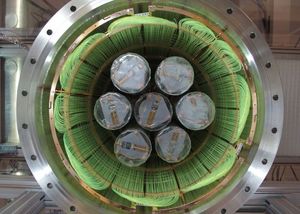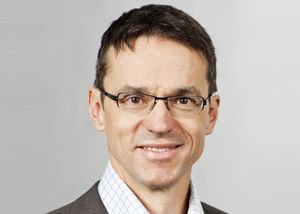In the GERDA experiment, in operation from 2011 to 2020, scientists from the GERDA collaboration investigated whether the neutrino was its own antiparticle. Neutrinos of this type are known as “Majorana” neutrinos. Like the LEGEND experiment, GERDA also employed detectors made of germanium-76. The nuclei of this material can decay, at least in theory, via neutrinoless double beta decay. Proof of such decay would confirm that the neutrino is identical with its own antiparticle, the anti-neutrino.
In its search for this decay, which, if at all, only occurs extremely rarely, the GERDA experiment utilized a total of 40 kilograms of detector material. This is equivalent to approximately 1026 germanium-76 nuclei. Scientists in the GERDA experiment developed and deployed various innovative concepts and techniques to create an environment with as low a level of radiation as possible. This approach allowed them recognize potential background radiation and eliminate it, respectively. GERDA was the first “background-free” experiment in the field.
After its nine-year lifetime, the GERDA experiment was able to rule out with 90 percent certainty that the half-life of neutrinoless double beta decay was less than 1.8 x 1026 years. Half-life is defined as the time taken for a nucleus, in this case a germanium nucleus, to decay at a 50 percent probability.
The GERDA collaboration consists of about 120 members from 16 institutes in six European countries, including the Max Planck Institute for Physics (MPP) and the Max Planck Institute for Nuclear Physics. The GERDA Group at the MPP was responsible for constructing and operating the cleanroom above the cryostat and for designing and constructing the set-up used to sink the detectors into the argon tank, known as the lock system. The group was and is still significantly involved in analyzing the data.
The GERDA experiment was conducted in two phases. In the first phase, the collaboration used detectors that it had “inherited” from previous experiments.
In the second phase of the experiment, a new detector type was employed. This was developed and fabricated specifically for the GERDA experiment. In addition, the set-up was modified by installing additional light sensors in the immediate vicinity of the germanium detectors. The sensors enabled the scientists to identify, and hence rule out, certain background events.
The experimental setup was constructed from 2008 to 2010. Data collection from the first phase of the GERDA experiment lasted from November 2011 to May 2013. Data were collected using a total of eight germanium detectors enriched with the isotope germanium-76.
The level of background radiation achieved corresponded to the targets set for the experiment. In the energy range of interest, the “background index” was 20 events (energy deposits in one of the germanium detectors in the appropriate energy range) per metric ton of germanium per year of data collection in an energy interval of one kiloelectronvolt. The composition of the energy spectrum was largely characterized in a doctoral thesis completed at the MPP.
No excess events were detected at an energy where such a signal might have been expected. This non-observation of decay enabled the experiment to establish a lower limit for the half-life of neutrinoless double beta decay in germanium-76 of 2.1 x 1025 years (with a confidence level of 90%).
To install additional detectors and light sensors, the set-up had to be significantly modified. The MPP group was responsible, in particular, for updating and constructing an enhanced lock system.
The second phase of GERDA, which collected data using 40 germanium detectors along with the additional light detector system, was conducted from December 2015 to December 2019. Phase two was also unable to detect a single energy deposit that could be attributed to neutrinoless double beta decay. The new lower limit for the half-life of germanium-76 was thus increased to 1.8 x 1026 years, the largest half-life limit for neutrinoless double-beta decay ever established. This half-life limit can be translated into an upper limit for the Majorana neutrino mass of 150–250 millielectronvolts. A Majorana neutrino would thus be at least 2,500,000 times lighter than an electron.
In the second phase of the GERDA experiment, the researchers were successful in showing that background signals caused by natural radioactivity could be reduced by a factor of ten. This was achieved by means of a new shielding technique. This achievement is an essential prerequisite for embarking on ambitious projects such as the even more sensitive LEGEND experiment.
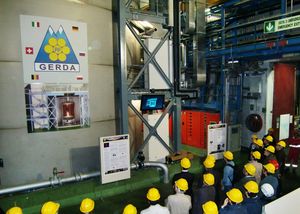
Final results and completion of the GERDA experiment
The search for neutrinoless double-beta decay continues with new LEGEND experiment
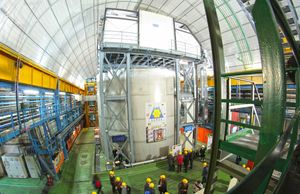
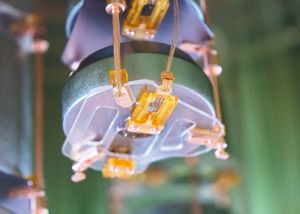
![[Translate to English:] [Translate to English:]](/fileadmin/_processed_/a/f/csm_7zu5_GERDA-1_a917dd2036.jpg)
